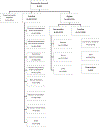A Prospective Longitudinal Study of Trajectories of Depressive Symptoms After Dysvascular Amputation
- PMID: 30605638
- PMCID: PMC7504975
- DOI: 10.1016/j.apmr.2018.11.024
A Prospective Longitudinal Study of Trajectories of Depressive Symptoms After Dysvascular Amputation
Abstract
Objectives: Characterize the course of depressive symptoms during the first year after dysvascular amputation and identify factors that predict symptom trajectories.
Design: Prospective cohort study of individuals undergoing lower extremity amputation (LEA), surveyed at 4 time points (perioperative period, 6 weeks, 4 months, and 12 months postamputation). Multilevel modeling was used to describe and predict trajectories.
Setting: Four Veterans Affairs medical centers, a university hospital, and a level I trauma center.
Participants: Participants (N=141; 74% retention) were a consecutive sample, eligible if they were undergoing their first unilateral LEA secondary to dysvascular disease.
Interventions: Not applicable.
Main outcome measure: Patient Health Questionnaire-9.
Results: Approximately 40% of participants endorsed at least moderate depressive symptoms at perioperative baseline. Individuals with greater depressive symptoms in the perioperative period concurrently reported greater pain, poorer self-rated health, and prior mental health treatment. In the first 6 weeks after amputation there was a substantial improvement in depressive symptoms, especially among individuals with greater symptoms at baseline. Depressive symptoms were generally stable after 6 weeks. None of the covariates assessed significantly predicted trajectories of depressive symptom improvement.
Conclusions: Watchful waiting may be the most appropriate course of action for many patients in the first 6 weeks after amputation. After 6 weeks, however, symptom levels tend to stabilize, suggesting that active intervention is called for if patients remain depressed at this point. Some patients may benefit from more proactive intervention, such as those with prior mental health treatment histories.
Keywords: Amputation; Depression; Rehabilitation.
Published by Elsevier Inc.
Figures




Similar articles
-
Suicidal ideation among individuals with dysvascular lower extremity amputation.Arch Phys Med Rehabil. 2015 Aug;96(8):1404-10. doi: 10.1016/j.apmr.2015.04.001. Epub 2015 Apr 14. Arch Phys Med Rehabil. 2015. PMID: 25883037 Free PMC article.
-
Quality of Relationships With Caregivers, Depression, and Life Satisfaction After Dysvascular Lower Extremity Amputation.Arch Phys Med Rehabil. 2018 Mar;99(3):452-458. doi: 10.1016/j.apmr.2017.09.110. Epub 2017 Oct 5. Arch Phys Med Rehabil. 2018. PMID: 28987901 Free PMC article.
-
Mobility changes in individuals with dysvascular amputation from the presurgical period to 12 months postamputation.Arch Phys Med Rehabil. 2012 Oct;93(10):1766-73. doi: 10.1016/j.apmr.2012.04.011. Epub 2012 Apr 24. Arch Phys Med Rehabil. 2012. PMID: 22543258 Free PMC article.
-
The experiences and needs of people with dysvascular lower extremity amputations: a qualitative systematic review and meta-synthesis.Disabil Rehabil. 2024 Nov;46(22):5169-5182. doi: 10.1080/09638288.2023.2291552. Epub 2023 Dec 7. Disabil Rehabil. 2024. PMID: 38062867
-
Limb loss: The unspoken psychological aspect.J Vasc Nurs. 2016 Dec;34(4):128-130. doi: 10.1016/j.jvn.2016.06.001. J Vasc Nurs. 2016. PMID: 27863589 Review.
Cited by
-
Comparison of Pre-existing Mood Disorders and Chronic Kidney Disease as Predictors of Ambulatory Status After Major Limb Amputation.Cureus. 2023 May 19;15(5):e39215. doi: 10.7759/cureus.39215. eCollection 2023 May. Cureus. 2023. PMID: 37337488 Free PMC article.
-
Self-Management to Improve Function After Amputation: A Randomized Controlled Trial of the VETPALS Intervention.Arch Phys Med Rehabil. 2021 Jul;102(7):1274-1282. doi: 10.1016/j.apmr.2021.02.027. Epub 2021 Apr 1. Arch Phys Med Rehabil. 2021. PMID: 33811854 Free PMC article. Clinical Trial.
-
Exploring patients' experiences of analgesia after major lower limb amputation: a qualitative study.BMJ Open. 2021 Dec 1;11(12):e054618. doi: 10.1136/bmjopen-2021-054618. BMJ Open. 2021. PMID: 34853109 Free PMC article. Clinical Trial.
-
The effect of depression on prosthesis prescription in men and women who have undergone a lower limb amputation.Disabil Rehabil. 2024 Mar;46(6):1204-1211. doi: 10.1080/09638288.2023.2192976. Epub 2023 Apr 10. Disabil Rehabil. 2024. PMID: 37035925 Free PMC article.
-
Long-term risk prediction after major lower limb amputation: 1-year results of the PERCEIVE study.BJS Open. 2024 Jan 3;8(1):zrad135. doi: 10.1093/bjsopen/zrad135. BJS Open. 2024. PMID: 38266124 Free PMC article.
References
-
- Horgan O, MacLachlan M. Psychosocial adjustment to lower-limb amputation: a review. Disabil Rehabil 2004;26:837–50. - PubMed
-
- Uzun O, Yildiz C, Ates A, Cansever A, Atesalp AS. Depression in men with traumatic lower part amputation: a comparison to men with surgical lower part amputation. Mil Med 2003;168:106–9. - PubMed
-
- Singh R, Ripley D, Pentland B, et al. Depression and anxiety symptoms after lower limb amputation: the rise and fall. Clin Rehabil 2009; 23:281–6. - PubMed
-
- Kratz AL, Williams RM, Turner AP, Raichle KA, Smith DG, Ehde D. To lump or to split? Comparing individuals with traumatic and nontraumatic limb loss in the first year after amputation. Rehabil Psychol 2010;55:126–38. - PubMed
-
- Coffey L, Gallagher P, Horgan O, Desmond D, MacLachlan M. Psychosocial adjustment to diabetes-related lower limb amputation. Diabet Med 2009;26:1063–7. - PubMed
Publication types
MeSH terms
Grants and funding
LinkOut - more resources
Full Text Sources
Medical

